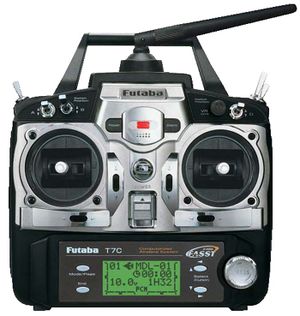Transmitter
In electronics and telecommunications a transmitter or radio transmitter is an electronic device which, with the aid of an antenna, produces radio waves. The transmitter itself generates a radio frequency alternating current, which is applied to the antenna. When excited by this alternating current, the antenna radiates radio waves.

The first general use of radio control systems in models started in the early 1950s with single-channel self-built equipment; commercial equipment came later. The advent of transistors greatly reduced the battery requirements, since the current requirements at low voltage were greatly reduced and the high voltage battery was eliminated. In both tube and early transistor sets the model's control surfaces were usually operated by an electromagnetic escapement controlling the stored energy in a rubber-band loop, allowing simple on/off rudder control (right, left, and neutral) and sometimes other functions such as motor speed.[1]
Transmitters talk to Receivers.
Transmitter Functions
F Mode
The "F MODE " or flight mode switch allows you to switch between different throttle curves and pitch curves during flight; indeed for 3D flying.
with helicopters A pilot may set a throttle curve that pretty much keeps the motor wide open no matter where the throttle stick is. Then the stick only controls the pitch of the main blades....Above 50% is positive pitch and below 50% is negative pitch; this is what allows a heli to fly upside down.
Hold Mode
Heading hold mode does the same thing but also keeps the nose pointed in a specific heading until it receives rudder input to change the heading.
References
- ↑ Fort Smith Flightmasters: Radio Control Systems (Part 2) with illustrations of an early installation and descriptions of various escapements.
